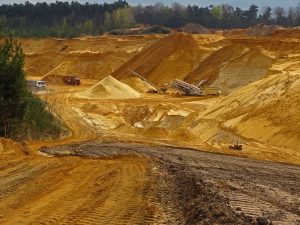We are running out of sand
Sand is “perceived as cheap, available and infinite and that is partly because the environmental and social costs are pretty much not priced in.”
.
Should ‘development’ have to be about ‘extraction’?
The construction industry consumes 75% of the earth’s natural resources – Vision Group for Sidmouth
.
In particular, should we be depending on the extraction of sand and gravel?
A mix of sand and gravel is properly known as aggregate but the word sand is often instead as a short-hand term when referring to construction it seems: this can be confusing. To a lay person sand and gravel are quite different things.
.
Those pieces were from 2017/18 – but we are now looking at a worldwide shortage of sand for pretty much everything, from construction to making glass and smartphones, with a piece this weekend from CNBC:
.
A sand shortage? The world is running out of a crucial — but under-appreciated — commodity
- Sand is the world’s most consumed raw material after water and an essential ingredient to our everyday lives.
- Yet, the world is facing a shortage — and climate scientists say it constitutes one of the greatest sustainability challenges of the 21st century.
- “Is it time for panicking? Well, that will certainly not help, but it is time to take a look and change our perception about sand,” said Pascal Peduzzi, a climate scientist with the United Nations Environment Programme.
‘We just think that sand is everywhere,’ Pascal Peduzzi said during a recent webinar hosted by think tank Chatham House, ‘We never thought we would run out of sand, but it is starting in some places,’ Peduzzi added.
Louise Gallagher, environmental governance lead at the UNEP/GRID-Geneva’s Global Sand Observatory Initiative, said the issues around sand had become a “diffuse” and “complex” problem to resolve. Sand is “perceived as cheap, available and infinite and that is partly because the environmental and social costs are pretty much not priced in,” Gallagher said on Tuesday during the same webinar.
“It seems like we believe the highest use value for this material right now is to extract it from the natural environment rather than keeping it in the system for the other types of benefits we get from it like say, for example, climate resilience in coastal areas,” she continued.
Sand shortage: The world is running out of a crucial commodity
.
If we look closer to home, the current Beach Management Plan includes beach nourishment (or beach replenishment) – defined as the supply of material that has been dredged from the seabed or extracted from inland sand and gravel pits.
http://www.sussex.ac.uk/geography/researchprojects/BAR/publish/Phase-1-final-Beach-recharge.pdf
.
 The report put together by the VGS for the Advisory Group meeting in February questioned the sustainability of beach nourishment/ replenishment:
The report put together by the VGS for the Advisory Group meeting in February questioned the sustainability of beach nourishment/ replenishment:
One expert speaking at a January 2019 conference at the British Geological Society estimated that the demand for sand for beach nourishment globally was likely to rise from 50 million cubic metres today (roughly 80 million tonnes) to 500 million cubic metres by 2050 (roughly 800 million tonnes).
[Driven to Extraction: Can Sand Mining be Sustainable? by Oli Brown and Pascal Peduzzi | Hoffmann Centre for Sustainable Resource Economy]
BMP framework analysis – VGS – 14feb21.
.
And as a correspondent says:
“This means that for me beach recharge is a bad option: we need nature to do the work for us by using offshore structures of some kind which naturally accumulate material at a speed which doesn’t wreck habitats.”
.
photo: Open Pit Mining Sand Raw Materials – Free photo on Pixabay